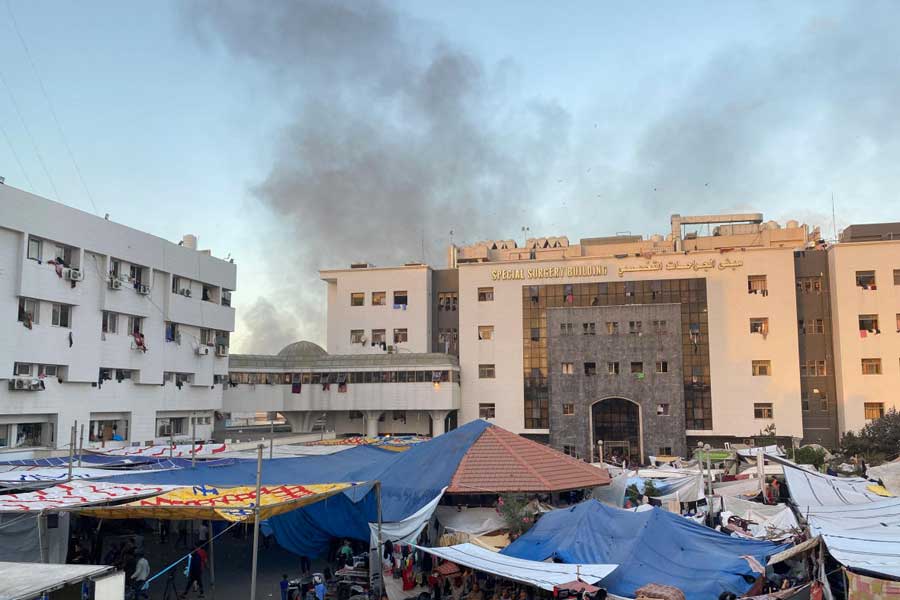Lena Beseiso pulled her blanket closer as she lay on the cold tile floor and waited for the bombs to fall.
Her husband, two of their daughters, their 10-year-old grandson and Beseiso’s 87-year-old mother-in-law were stretched out in the same room, silently willing themselves into an uneasy sleep.
Nights were the worst, and on this night, their eighth in the Gaza Strip since the war began, Beseiso knew what would come. The rumbling grew louder. She felt the building shudder. She could just make out the figures of her family around her in the dark. Would they survive another night?
“I need to go back home,” she thought.
Home was 11,265km away in Salt Lake City.
Earlier that day, Beseiso had received an email from the US state department that the Rafah crossing, between Egypt and Gaza, would be open for US citizens. So for the second time in a week, her family would pack up and make the risky trek to the border crossing.
The first time they had gone, the crossing had been hit by an Israeli airstrike. They saw a blast in front of the main gate, Beseiso recalled. “Everybody was just like, ‘We’ll never get out of hell.’”
This time, Beseiso’s family was told the crossing would open at noon. Three hours later, it was still closed, with no officials in sight.
Over several weeks, Beseiso sent daily texts and voice messages to a New York Times reporter, chronicling her time in Gaza. Health officials there count more than 11,000 deaths in little over a month since Israel began its counteroffensive after a surprise Hamas attack in which officials say 1,200 people were killed and more than 200 abducted.
Even as they dodged airstrikes and huddled terrified in the dark, the Beseisos became reluctant war correspondents, sending daily, and sometimes hour-by-hour, updates. The messages provide an intimate account of one family’s attempt to survive one of the most intense bombing campaigns this century.
Beseiso, 57, was born in Amman, Jordan, and immigrated with her siblings and parents, Palestinian refugees, to the United States in 1973, when she was 7 years old. They joined an uncle who had attended college in the US and who lived in Salt Lake City.
After finishing high school in 1984, Beseiso visited West Asia to see relatives and friends. On that trip, she also visited Gaza, where she met her future husband, Hamdy. They married, had five children and eventually decided to split their time between Utah and Hamdy’s family home in Gaza City.
Lena Beseiso, busy raising the children and worried by the rising tensions in West Asia, did not visit Gaza for 12 years. This year, as their youngest, Julia, 19, was graduating from high school, Beseiso thought it was a good time for a mother-daughter trip to Europe and West Asia. Beseiso’s husband, grandson and several of her other children — all US citizens — were already in Gaza on an extended stay.
It was a joyous reunion. Suhayla, Julia’s grandmother and the family matriarch, lived on the first floor of the family’s building. As her children married, they moved into their own spaces on the floors above, where they raised their families. The entire building held generations of Beseisos.
Julia returned to the US over the summer to get ready for her first year of college. Her mother and sisters stayed behind to renew two expired passports and planned to follow.
Lena Beseiso and her family were shocked when they saw reports of the Hamas attack on October 7. People in Gaza expected Israel would respond, but the Beseisos were unprepared for what followed.
The pounding was relentless, Lena Beseiso said. She just wanted to escape this new and brutal war.
On October 13, the sky rained leaflets. Israel was warning people in the area to go south. But Beseiso had heard reports that some families fleeing in that direction had died in airstrikes on the road. And where would their large clan go?
Still, the family drove south — a long, slow journey through flattened neighborhoods and blasted streets. Beseiso had no idea where they would end up. Then, at 2:47pm local time, she texted, “We found a family that let us in,” followed by five crying emojis.
The sound of the airstrikes was now distant. For the first time in days, Beseiso slept for a bit.
But the apartment they had crammed into was overflowing with people also fleeing airstrikes. Hamdy, her husband, called an old acquaintance in southern Gaza he had not seen in years and asked if his friend could house his family.
They moved into the new apartment and all slept together in the living room, with most of the family sleeping on the tiled floor.
One of Lena Beseiso’s sons reached out to US officials in the state department, Congress and the White House, pleading for more help.
Through a contact, the Beseisos were able to reach the office of US Representative Mike Lawler. Lawler’s district director, Rafi Silberberg — whose job also involves outreach to the Orthodox Jewish community — said he stayed in daily contact with the Beseisos, providing updates on US evacuation efforts.
New York Times News Service











